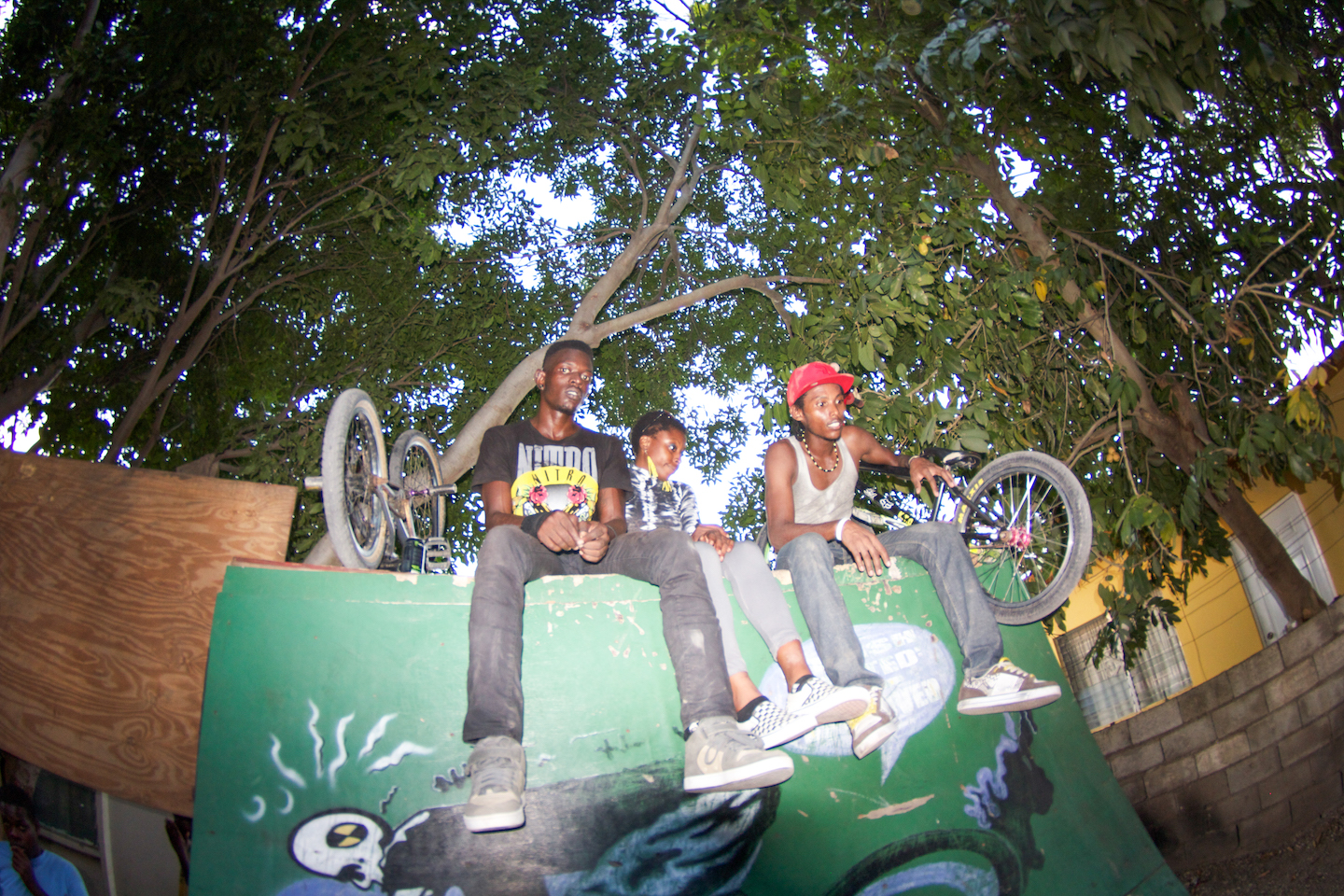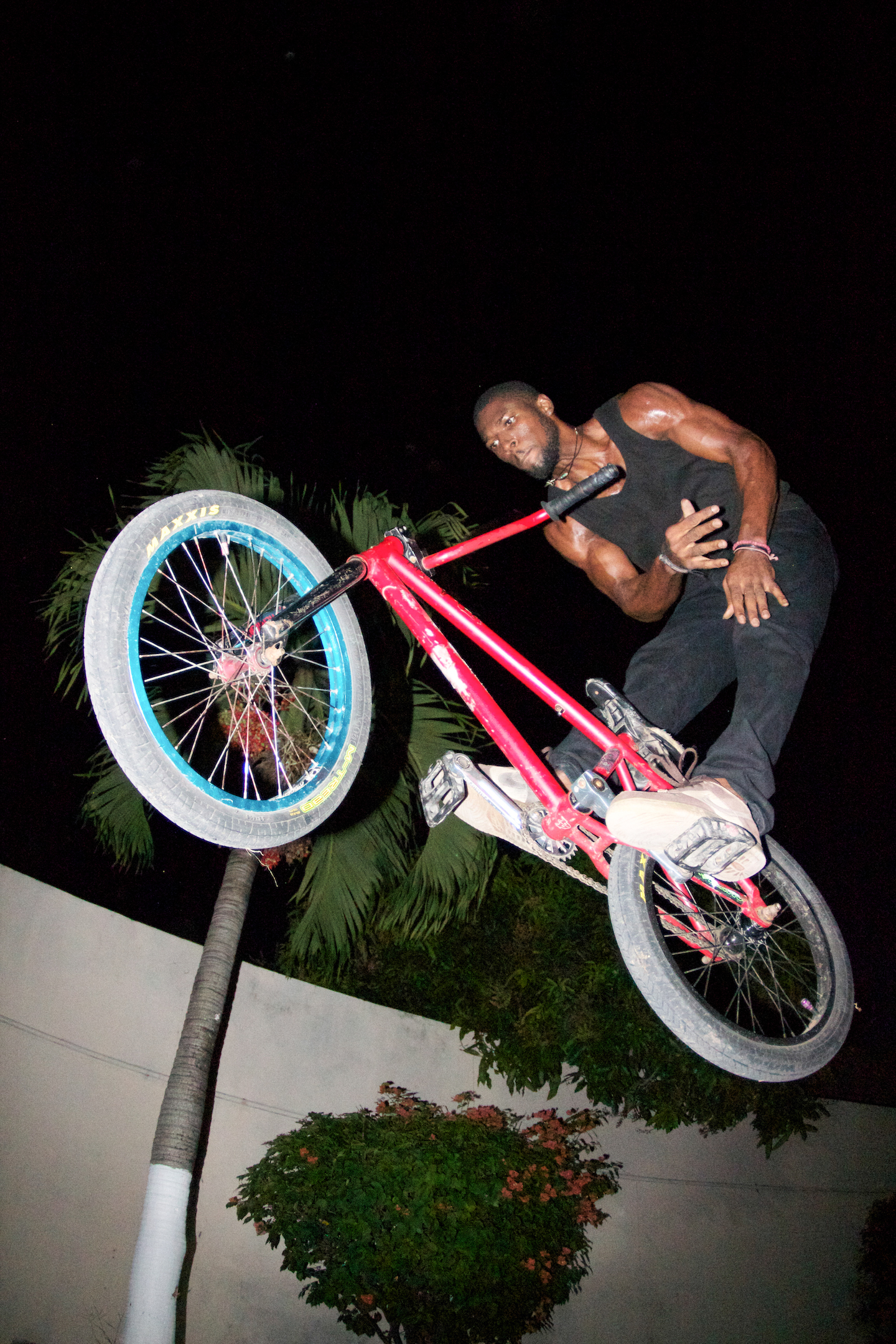Back in 2006, when I was just a shy 12-year-old from New Jersey, I got to meet Richard “A-Wire” Lecky at Woodward Camp, an extreme sports mecca in Pennsylvania.
I was a skateboarder, and Lecky was a 21-year-old BMX rider (sponsored by Red Bull) visiting from Jamaica, where he was almost single-handedly driving the island’s nascent extreme sports scene. Skaters and BMX riders would usually stick to their own groups at these camps, but I made it my mission to trail him around and get to know him. What began was a seven year journey in which Lecky took me under his wing, and I got to witness and document the birth of Jamaica’s wild and fearless BMX culture.
Videos by VICE
My family and I would visit Jamaica to see Lecky, and he would visit us in New Jersey. It was hard to get imported goods in Jamaica, so he would often order bike parts to our house, disassemble them and take them back to the island in various bags of luggage.
When we visited the island in 2006, a vert ramp had just been built. These backyard ramps (documented in the photos below) were located at the house of Damien Douglas – one of Lecky’s friends – and comprised what was basically Jamaica’s very first BMX skatepark. It became known as the “KTD Compound”, which stood for Krash Test Dummies.

The ramps were steep and battered, not like the glossy ramps I skated in the US. Large chunks were missing from the plywood surface, and 2x4s were used for structural support, with rocks wedged under them to keep them level. They seemed sketchy to me, but to the crew that built them they were everything. Kids from the neighbourhood would gather and watch the riders practice fearlessly; you could tell they loved the excitement it brought to the community.
When I visited again in 2010, I started documenting Lecky and his extreme sports-loving friends with my camera more closely. He was the country’s BMX poster boy, and was unapologetically himself: covered in piercings and wearing different clothes to everyone else. His circle was a strange sight to many Jamaicans. A lot of people had never even seen someone hop through the air on a bicycle, so when they would fly by, jump onto a ledge, and then grind a metal rail on their pegs, bystanders would stand and watch in shock.

Since very few people knew about BMX rider culture, they would commonly refer to Lecky and his crew as “stuntmen” – and that’s how the Krash Test Dummy Stunt Team was born. The crew would ride all day at the KTD Compound in the 32°C heat and 85 percent humidity, and throw parties in the evenings. Some days they would ride the streets of Kingston, dodging potholes and maniac drivers, in search of new spots to conquer. Then they’d go home, read Transworld BMX magazine and consume videos recorded by pros overseas to get inspiration for new tricks.
The Krash Test Dummy Stunt Team was ground zero for what became Jamaica’s thriving extreme sports culture. The days of backyard ramps are over – there’s now a skate shop and two professionally-built and publicly accessible skateparks on the island.

I interviewed Lecky recently and asked him to tell the story of how he first discovered BMX riding, how he learned to bunny hop, and how the scene has evolved in Jamaica up to today.
VICE: Tell me where you’re from in Jamaica. What was that area like growing up? Lecky: I was born in Kingston and grew up in a little undeveloped community in Spanish Town called Jones Avenue. It was basically a ghetto area without running water or proper roads. Even though I lived there, my parents instilled in me that where I lived never defined the person I am. I was the weirdo in my community, not conforming to social norms.
**What did kids do for fun there?
**They would play football, basketball, track and field, and cricket – hoping to become the next star athlete to move out and make it big. Extreme sports were never a thing. A few guys, including my brother, would set up the bicycles for speed, but that was as extreme as it got there.

**So, what sparked your interest in BMX?
**One morning, I was watching a program on the TV called Gillette World Sports Special. It was an international broadcast, and they showed athletes from all across the world, something like Red Bull TV today. And I saw some guys riding trials and hopping on barrels – I was amazed. It was the first time in my life I’d seen anyone ride a bicycle like that.
**So once you saw that, what next?
**I think this was 1994. After that, I started tuning in every weekend religiously, just to get a glimpse of the guys riding. It sent me on a path to start searching for riders or bikes that looked like them in my local shops. But no luck: I saw no one and no bikes. I wasn’t deterred, though. I kept dreaming and thinking about how I’d get a bike, but I had bigger problems at hand… I didn’t know how to ride a bicycle at the time. So I started telling myself I could ride, and literally convinced myself that I can ride, and a friend’s little sister had a 16” [wheel] girls bike, and I took it and started riding. Eventually, I would try to bunny hop and do wheelies, and I was getting the hang of it and started hopping potholes. Oftentimes, I would fall or break the bike, and I would have to fix it.
Then, one day when I was out, I saw a guy appear out of nowhere on a BMX and hop a curb. So I rode him down, asking if he would sell it. He looked at me and laughed and told me it was dangerous. But from that day, I knew it was possible, and my goal was to get my own bike. Like a year or two later, I saw another guy riding, and like the first, I chased him down and asked about his bike and told him I wanted to learn. He told me if I wanted a bike and to learn, a guy called G-Dogg would be the best person to talk to. He gave me directions to his house and left. I went to G-Dogg’s house and saw his mom; she told me he was around the back. I introduced myself; he loaned me a BMX Plus magazine to take home. He became my mentor, and the rest is history.

**But there was no culture or scene yet, right? No ramps?
**At the time, it was very underground. As I started riding with my mentor, I realised pockets of riders would appear here and there, but G-Dogg was the scene, and everyone rode flat land. Also, people classified them as insane or, in Jamaican terms, madman.
How and when did the KTD crew form?
The crew formed around 2004/05. My mentor migrated to the US, and I was pretty much left responsible for representing the scene in Spanish Town. As my skills grew, I started taking riding to another level and started recruiting and mentoring a new generation of riders. After the scene got big, I remembered talking to G-Dogg about possibly doing shows for money – I took that idea, formed the team, and began marketing it.
How did most Jamaicans view you and your friends?
They thought we all were crazy with a death wish, and even called us “Oreo” [laughs]. No one supported it, really, not parents or friends. Most people hyped us up to fall so they could have a good laugh.

There’s this punk/anarchist/oddball stigma sometimes associated with extreme sports, even in the US, but in Jamaica even more so.
I never really felt like I could relate to the people around me; the things I liked were considered weird. I liked rock and techno music, which heavily influenced my speech and dress.
How did you overcome challenges or obstacles when trying to pursue BMX in an environment where it wasn’t widely understood or supported?
Hard work, being consistent, and never giving up. But, on the real, it was like my drug; it’s all I talked about, and it became my life. On one end, it was hard, but on the other, it was my life.
**How has the BMX scene in Jamaica evolved since you first started riding?
**Right now, the scene in Jamaica has grown so much, with two public skate parks, a lot more talented riders and easier access to parts. It’s on a whole other level right now. I’ve inspired so many kids during that time, giving them a vision and a dream of what’s possible in BMX and action sports.

What advice would you give to young aspiring BMX riders in Jamaica who may face similar challenges to those you encountered?
Just ride, listen to the people who support you, and just ride.
Have you had any opportunities to collaborate with international BMX riders or participate in events outside of Jamaica?
Plenty – I’ve travelled to many states in the US because of my riding, was invited to the grand opening of Camp Woodward in Tahoe, and was on MTV on the Nitro Circus TV show hosted by motocross legend Travis Pastrana. I did commercials for Sony in Japan, was also featured in Creamè BMX magazine out of France, and was on the cover of Jae magazine. I also spent two weeks riding, skiing and filming with legendary skiers Tanner Hall, Sammy Carlson, Henrik Harlaut, and Phil Casabon, to name just a few.
What are your goals and aspirations for the future of BMX in Jamaica, both personally and for the community as a whole?
The one thing left to accomplish is to start a training camp/bike shop where I can share the knowledge that I’ve learned over the years and mentor kids on reaching their full potential. As for me personally, I’m at a point where I’m content with my accomplishments and the life I’ve lived. I just want to be buttery smooth and just flow.
Additional photos:







More
From VICE
-

Beachcombers of Newfoundland and Labrador / Facebook -

Collage by VICE -

Cole and Calvin, cousins, 2017. All photos courtesy of the artist and Dallas Contemporary. -

Photo by Norm Lane


